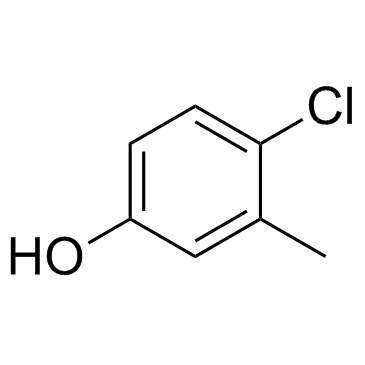4-Chloro-3-methylphenol

4-Chloro-3-methylphenol structure
|
Common Name | 4-Chloro-3-methylphenol | ||
|---|---|---|---|---|
| CAS Number | 59-50-7 | Molecular Weight | 142.583 | |
| Density | 1.2±0.1 g/cm3 | Boiling Point | 235.0±0.0 °C at 760 mmHg | |
| Molecular Formula | C7H7ClO | Melting Point | 63-65 °C(lit.) | |
| MSDS | Chinese USA | Flash Point | 93.4±21.8 °C | |
| Symbol |



GHS05, GHS07, GHS09 |
Signal Word | Danger | |
|
Ca(2+) permeation and/or binding to CaV1.1 fine-tunes skeletal muscle Ca(2+) signaling to sustain muscle function.
Skelet. Muscle 5 , 4, (2015) Ca(2+) influx through CaV1.1 is not required for skeletal muscle excitation-contraction coupling, but whether Ca(2+) permeation through CaV1.1 during sustained muscle activity plays a functional role in mammalian skeletal muscle has not been assessed.We gener... |
|
|
Intracellular Ca(2+)-handling differs markedly between intact human muscle fibers and myotubes.
Skelet. Muscle 5 , 26, (2015) In skeletal muscle, intracellular Ca(2+) is an important regulator of contraction as well as gene expression and metabolic processes. Because of the difficulties to obtain intact human muscle fibers, human myotubes have been extensively employed for studies o... |
|
|
Synthesis and Characterization of Gelatin-Based Magnetic Hydrogels.
Adv. Funct. Mater. 24(21) , 3187-3196, (2015) A simple preparation of thermoreversible gelatin-based ferrogels in water provides a constant structure defined by the crosslinking degree for gelatin contents between 6 and 18 wt%. The possibility of varying magnetite nanoparticle concentration between 20 an... |
|
|
Determination of phenolic disinfectants in consumer products by capillary electrophoresis with amperometric detection.
J. Chromatogr. Sci. 48(7) , 584-8, (2010) Numerous disinfection products are widely used in daily life to kill pathogenic microorganisms. However, most disinfectants are organic compounds that might be hazardous to the environment and humans when used excessively. Phenolic disinfectants in disinfecti... |
|
|
Analysis of phenolic compounds in the dissolved and suspended phases of Lake Balaton water by gas chromatography-tandem mass spectrometry.
Environ. Sci. Pollut. Res. Int. 22 , 11966-74, (2015) As a novel approach to characterize the phenolic pollutants of Lake Balaton (Central Europe, western Hungary), 26 endocrine disrupting phenols (chlorophenols, nitrophenols, alkylphenols, triclosan, bisphenol-A) were quantified in dissolved and suspended parti... |
|
|
Control of Giardia infections with ronidazole and intensive hygiene management in a dog kennel.
Vet. Parasitol. 187(1-2) , 93-8, (2012) Infections with the intestinal protozoan parasite Giardia in dogs and cats are common. Clinical signs vary from asymptomatic to small bowel diarrhea and associated discomfort. The control of infections in dogs is frequently a frustrating issue for animal owne... |
|
|
S100A1 promotes action potential-initiated calcium release flux and force production in skeletal muscle.
Am. J. Physiol. Cell Physiol. 299 , C891-902, (2010) The role of S100A1 in skeletal muscle is just beginning to be elucidated. We have previously shown that skeletal muscle fibers from S100A1 knockout (KO) mice exhibit decreased action potential (AP)-evoked Ca(2+) transients, and that S100A1 binds competitively... |
|
|
Functional ryanodine receptors in the plasma membrane of RINm5F pancreatic beta-cells.
J. Biol. Chem. 284(8) , 5186-94, (2009) Ryanodine receptors (RyR) are Ca(2+) channels that mediate Ca(2+) release from intracellular stores in response to diverse intracellular signals. In RINm5F insulinoma cells, caffeine, and 4-chloro-m-cresol (4CmC), agonists of RyR, stimulated Ca(2+) entry that... |
|
|
Functional characterization of ryanodine receptor (RYR1) sequence variants using a metabolic assay in immortalized B-lymphocytes.
Hum. Mutat. 30(4) , E575-90, (2009) Mutations in the RYR1 gene are linked to malignant hyperthermia (MH), central core disease and multi-minicore disease. We screened by DHPLC the RYR1 gene in 24 subjects for mutations, and characterized functional alterations caused by some RYR1 variants. Thre... |
|
|
In vitro dermal penetration of 4-chloro-3-methylphenol from commercial metal working fluid and aqueous vehicles.
J. Toxicol. Environ. Health A 73(20) , 1394-405, (2010) The biocide 4-chloro-3-methylphenol (CMP, CAS number 59-50-7) is a common additive to metal-working fluids (MWF) and building materials. National Institute for Occupational Safety and Health (NIOSH) researchers previously identified and quantified CMP in a co... |